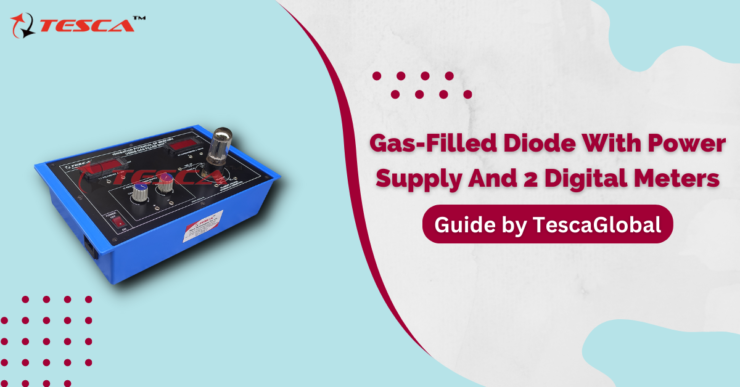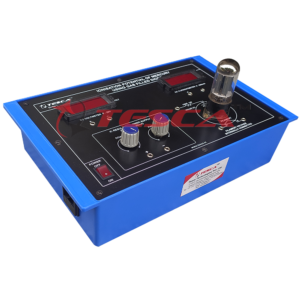Table of Contents
Uses, Working Principle, Components and Type of Gas-Filled Diode
Science has advanced quite a bit, and many development tools are now available. One such tool is a gas-filled diode. A gas-filled diode is a three-terminal electronic device with a gas-filled region in its center. It is a voltage-operated switch that uses a small amount of electrical input to control a more significant current flow, making it useful in many power control applications. This blog will give insights into their working, properties and applications:
What is a Gas Filled Diode?
A gas-filled diode is a type of diode that contains a gas within its structure. In a gas-filled, there are two main parts, the anode and the cathode. There are two different gasses in these parts, and the difference in these gasses helps the device perform its tasks. The gas helps to provide a barrier between the anode and cathode, which allows the diode to function more effectively. The gas also helps to dissipate heat, which can be a significant issue with diodes. Gas diodes are more efficient than standard diodes and can handle more power.
Uses of Gas-Filled Diodes?
- Gas-filled diodes are helpful in various applications, including RF power amplifiers, microwave ovens, and medical imaging. They are also used as voltage regulators and in high-voltage power supplies. Gas-filled diodes have several advantages over other diodes, including a higher breakdown voltage and a lower forward voltage drop.
- They are also helpful in some types of electronic warfare equipment. CFDs are more efficient than other diodes and can handle higher power levels.
- In the educational sector, gas-filled diodes are often helpful in experiments and demonstrations. They can help to show how electrical current works and how it can help create light.
- In the industrial sector, gas-filled diodes are useful in various devices, including lasers and night vision goggles.
Working Principle of Gas-Filled Diode?
A gas-filled diode is a type of diode that uses a gas as the primary charge carrier. The argon ion diode is the most common type of gas-filled diode, which uses argon atoms as the charge carriers. The working principle of a gas-filled diode is similar to that of a regular diode, except that it uses gas ions.
When a voltage applies to the diode, the gas ions attract the anode and flow through the gas to the cathode. This flow of ions creates a current through the diode, which is helpful to power an electrical circuit.
Components of Gas-Filled Diodes?
A gas-filled diode is a device that contains a small amount of gas sealed within its envelope. The gas is an inert gas such as argon or neon, and the envelope is typically a glass or quartz tube. The gas-filled diode helps protect electronic components from electrical surges. When an electrical surge occurs, the gas-filled diode conducts the wave to the ground, covering the electronic components.
Gas-Filled Diode Setup?
A gas-filled diode uses a gas as the primary medium for conduction. The gas is typically a noble gas, such as argon or xenon, and is generally mixed with a small amount of mercury. The gas filling provides several benefits over traditional solid-state diodes, including a higher breakdown voltage and a lower forward voltage drop.
The gas filling also provides a more uniform electric field across the diode, which results in a lower noise level. The most common type of gas-filled diode is the krypton-filled diode, which is used in high-voltage rectifiers.
To set up a gas-filled diode:
1. Connect the cathode, negative lead, to the power supply.
2. Click the anode, or positive information, to the load.
3. Attach a resistor between the anode and cathode to limit the current.
Gas-filled diodes are helpful in various applications, including high-voltage rectifiers, voltage regulators, and surge suppressors.
Types of Gas-Filled Diode?
There are three primary gas-filled diodes: the argon-filled diode, the krypton-filled diode, and the xenon-filled diode. Each type of diode has its unique properties and applications.
- Argon-Filled Diode:
The argon-filled diode is the most common type of gas-filled diode. It is typically helpful for low-voltage applications such as slight signal amplification.
- Krypton-Filled Diode:
The krypton-filled diode is a higher-voltage version of the argon-filled diode and is often helpful in power supplies and high-voltage switches.
- Xenon-Filled Diode:
The xenon-filled diode is the highest-voltage gas-filled diode and is helpful in high-voltage applications such as x-ray generators.
- Cold Cathode Gas Filled Diode:
A cold cathode gas-filled diode is an electrical device that uses a gas-filled tube to emit electrons. The gas inside the tube is typically a mixture of argon and mercury. When a voltage is applied to the electrodes, the gas ionizes, and electrons are emitted from the cathode. These electrons then travel to the anode, where they are collected.
Cold cathode gas-filled diodes have several advantages over other types of electrical devices. They are very efficient, have a long lifetime, and are relatively inexpensive to produce. Additionally, they are not affected by magnetic fields, making them ideal for use in high-voltage applications.
Gas Filled Diode Price?
Several factors determine the price of a gas-filled diode. The type of gas, the size of the diode, the manufacturer, etc., play a role in setting the price.
The most common type of gas used in gas-filled diodes is argon. Argon is a relatively inexpensive gas, so diodes that use it tend to be on the lower price spectrum. Diodes that use more expensive gasses, such as krypton or xenon, will be more expensive.
The size of the diode also plays a role in its price. Larger diodes are more expensive than smaller ones. This is because they require more gas to fill them, and the materials used to construct them are usually more costly.
The manufacturer of the diode also affects its price. Some manufacturers can produce diodes more cheaply than others. Retailers also play a role in setting the price of a gas-filled diode. Some retailers charge more for diodes than others.
In general, gas-filled diodes range in price from INR 1000 to INR 10,000. As mentioned earlier, the cost of a particular diode will depend on all the factors.
Read also: Importance of Power Electronics Lab Trainer Tools.
Tesca Global Gas Filled Diode?
If you’re searching for the best gas-filled diode in the market, look no further than Tesca Global. The Tesca Global Gas Filled Diode with Power Supply and two digital meters is a versatile and powerful tool for measuring and controlling gas flow. It is equipped with various features that make it ideal for many applications. The gas-filled diode provides a stable and safe environment for the user to work in.
- Its main features include a gas-filled diode, a power supply, and two digital meters.
- The power supply and digital meters provide accurate and reliable gas flow measurements, while the adjustable flow control valve allows you to precisely control gas flow.
- The unit also features a pressure relief valve, which helps prevent the system’s over-pressurization.
- The product comes with a power supply and two digital meters that help monitor the power output.
- The product is also equipped with a safety shut-off feature to prevent the device from overloading.
The Tesca Global’s Gas Filled Diode with Power Supply and 2 digital meters is an excellent product for those looking for a reliable way to power their devices. You’ll be able to get your work done without any disruptions. Get one for your workplace today!






Add comment